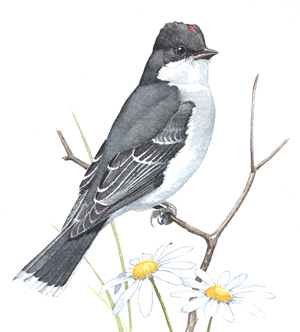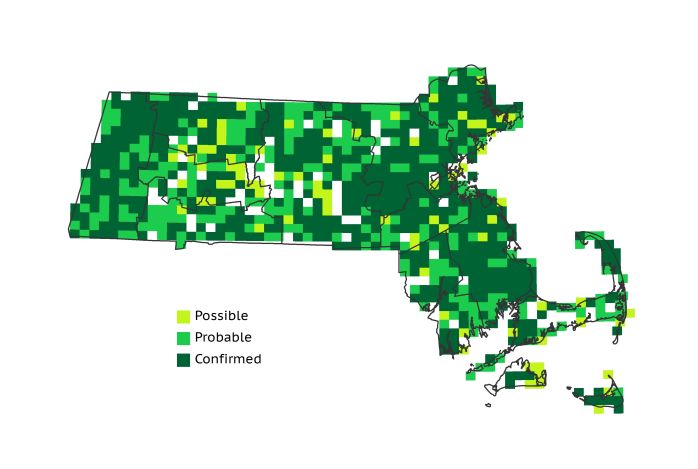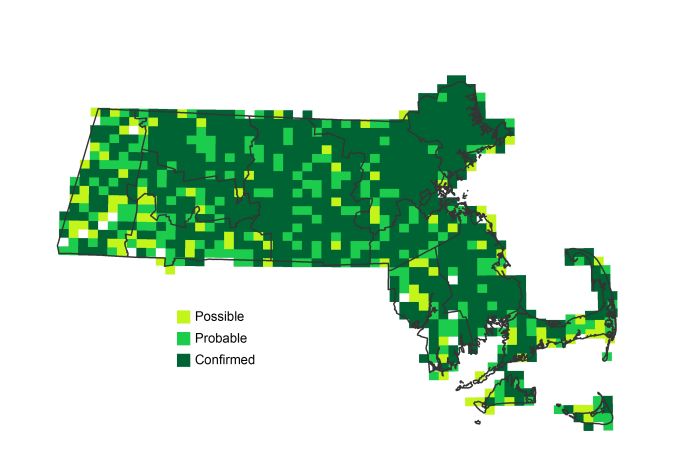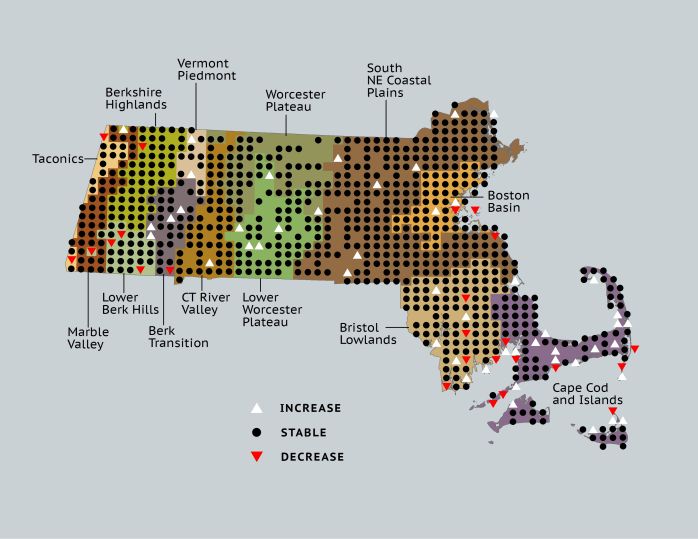Find a Bird
Eastern Kingbird
Tyrannus tyrannus

Nearly ubiquitous and stable
Action/monitoring needed
“I see at a distance a kingbird or blackbird pursuing a crow lower down a hill, like a satellite revolving around a black planet.” – Henry David Thoreau, Journal
Crowned with a small patch of red, a mark difficult to see even with a good view, Eastern Kingbirds thrive in parks, orchards, and lakesides where they patrol wooded edges for flying insects and potential intruders. This species was once known as the “Bee Martin” and was shot by beekeepers because it was believed to consume large numbers of drone bees. In fact, bees make up only a small portion of the Eastern Kingbird's diet. The species' Latin name, Tyrannus tyrannus, suggests the nearly maniacal tendency of these birds to chase and harass any bird that trespasses on their domain, from sparrows to hawks.
Historic Status
Its pugnacious attitude and fearless defense of its territory also helped the Eastern Kingbird gain its common name. “Some of the American Indians knew this bird as the ‘little chief,’” wrote Edward Howe Forbush in 1927, “but the English settlers, fleeing from tyranny at home, called him the King Bird” (Forbush 1927). The species inhabited our region before European settlers called the area Massachusetts, but it most likely flourished with the expansion of agriculture and orchard farming. Throughout the historic record, the species has been listed as a common summer resident and breeder in Massachusetts.
Atlas 1 Distribution
Brushy clearings, water margins, and forest edges hosted breeding kingbirds throughout the state in Atlas 1. From the Taconic Mountains to the Berkshire Transition, kingbirds were widespread. Block occupancy was slightly lower (about 84%) in the Berkshire Transition and Vermont Piedmont ecoregions, and the Lower Worcester Plateau had noticeable distribution gaps. Kingbirds were more evenly distributed in the Coastal Plains and the Boston Basin, where they demonstrated their ability to breed successfully in small parks and overgrown lots alongside human habitation. Occupancy dipped just below 90% in the Bristol/Narragansett Lowlands, and the Cape and Islands region had the lowest proportion of occupied blocks in the state despite the preponderance of available scrub habitat.
Atlas 2 Distribution and Change
When we look at the blocks with the best coverage from Atlas 1 and 2, the Eastern Kingbird distribution in Massachusetts appeared more or less stable. Slight fluctuations, such as the loss of kingbirds from 2 blocks in the Taconics or a 3-block net gain in the Berkshire Transition, characterized the species’ trend across western and central Massachusetts. Likewise, Eastern Kingbird distribution was mostly stable in the Boston Basin and expanded modestly in the Coastal Plains and the Bristol/Narragansett Lowlands. Like many flycatchers, kingbirds seemed to find the Cape and Islands a suitable venue for expansion, and evidence of breeding was found in 18 new blocks during Atlas 2 surveys.
Atlas 1 Map

Atlas 2 Map

Atlas Change Map

Ecoregion Data
Atlas 1 | Atlas 2 | Change | ||||||
Ecoregion | # Blocks | % Blocks | % of Range | # Blocks | % Blocks | % of Range | Change in # Blocks | Change in % Blocks |
Taconic Mountains | 15 | 93.8 | 1.8 | 16 | 64.0 | 1.7 | -2 | -13.3 |
Marble Valleys/Housatonic Valley | 39 | 100.0 | 4.6 | 39 | 100.0 | 4.0 | 0 | 0.0 |
Berkshire Highlands | 53 | 96.4 | 6.2 | 54 | 98.2 | 5.6 | 0 | 0.0 |
Lower Berkshire Hills | 27 | 96.4 | 3.2 | 24 | 77.4 | 2.5 | -4 | -14.8 |
Vermont Piedmont | 14 | 82.4 | 1.6 | 17 | 100.0 | 1.8 | 2 | 16.7 |
Berkshire Transition | 32 | 84.2 | 3.7 | 38 | 95.0 | 3.9 | 3 | 9.7 |
Connecticut River Valley | 52 | 92.9 | 6.1 | 62 | 95.4 | 6.4 | 1 | 2.1 |
Worcester Plateau | 74 | 94.9 | 8.6 | 85 | 96.6 | 8.8 | 1 | 2.1 |
Lower Worcester Plateau | 57 | 77.0 | 6.7 | 79 | 98.8 | 8.2 | 5 | 9.3 |
S. New England Coastal Plains and Hills | 251 | 93.0 | 29.3 | 278 | 98.2 | 28.9 | 7 | 3.1 |
Boston Basin | 50 | 89.3 | 5.8 | 51 | 91.1 | 5.3 | 0 | 0.0 |
Bristol and Narragansett Lowlands | 94 | 88.7 | 11.0 | 100 | 87.7 | 10.4 | 2 | 2.0 |
Cape Cod and Islands | 98 | 72.1 | 11.4 | 120 | 83.3 | 12.5 | 10 | 8.3 |
Statewide Total | 856 | 88.3 | 100.0 | 963 | 92.9 | 100.0 | 25 | 3.0 |
Notes
The Eastern Kingbird shows a significant decreasing Breeding Bird Survey (BBS) trend in Massachusetts, in the New England/Mid-Atlantic Region, and in the Eastern US overall.They fall into our “whispering bird” category – those species with a demonstrated stable or increasing breeding footprint from Atlas 2 data, but also a demonstrated decline in abundance from the BBS. This drives our final assessment that this is a species with a need for further monitoring.



